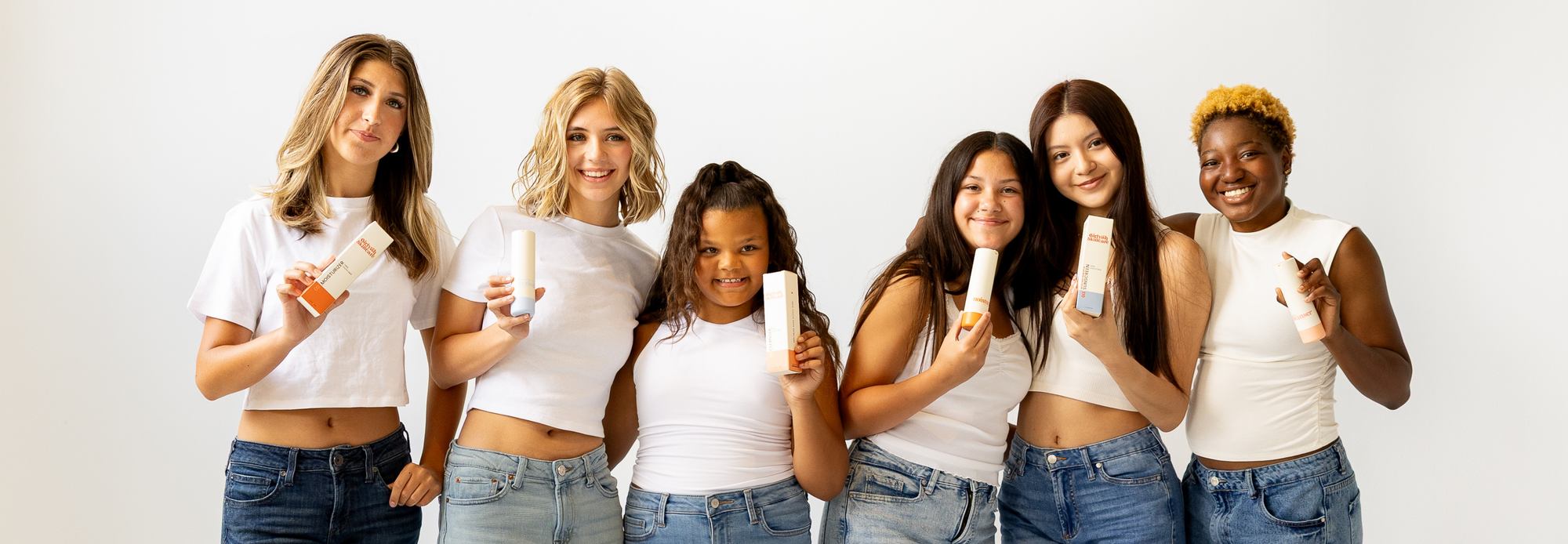

· By Macy Schmitt
What Is My Skin Type?
Whether you're just starting to explore your skincare journey or are looking to refine your current skincare routine, it’s important to understand your skin type. Asking yourself “What is my skin type?” is the first step for your skincare habits to actually work without causing more damage. Let’s break it down in a way that’s easy to understand, whether you’re a teen just starting out or an adult with a long history of skincare practices, it’s important to know about your skin type.
The 5 Basic Skin Types
It’s time to learn about each skin type and which one you fit into. With some exceptions, skin generally falls into one of these 5 categories, according to the American Academy of Dermatology.
Normal Skin
This skin type is well…normal! Normal skin is a balance between dry and oily, and tends to have small pores. Those with normal skin are less likely to experience frequent breakouts. If your skin doesn’t feel either tight or oily by midday and you rarely experience redness or irritation, there’s a good chance you have this skin type. Most people with this type don’t have to think about their skin all that much (lucky you!)
Oily Skin
With oily skin, more sebum (your skin’s natural oils) is produced than is needed. This leads to skin that becomes greasy quickly, clogged pores, and frequent breakouts. Other signs that this is your skin type is a shiny face, frequent blackheads, whiteheads, acne, and makeup that slides off easily.
Dry Skin
Dry skin is the opposite of oily. Not enough sebum is produced which leads to a tight feeling to your face, flakinesses or rough patches, and discomfort after cleansing. Those with dry skin will often have a dull look to their skin and experience frequent irritation. If you feel like you have to use an excessive amount of moisturizer, this may be your skin type!
Combination Skin
Put everything together from the last two skin types, and you have combination skin. This skin type, which is common in teens, means that certain areas of your face will share symptoms of oily skin, and others dry skin. Often, the T-zone tends to be more oily and other areas, like the cheeks, tend to experience dryness. It’s common to have both breakouts and rough patches, and you might feel caught between skincare products that work too well or not well enough.
Sensitive Skin
The 5th skin type is sensitive skin. If you feel like anything from the weather, new products, and even stress can throw off your skin’s health, you may have found your type! People with eczema or rosacea can often be classified as having sensitive skin. You may find that hot or cold weather is very uncomfortable to your skin, and you have frequent stinging, redness, and itching after applying skincare products.
How To Test Your Skin Type
If you are still feeling unsure, here’s a simple test that can help you determine what skin type you are. Start off by washing your face with a simple cleanser. Then, wait 30-60 minutes before putting on any products. Once the time is up, take a look at your skin. If your face looks overall shiny, you likely have oily skin. If it feels tight or is developing flaky spots, you probably have dry skin. If only the T-zone is shiny, or feels tight only in certain areas, there’s a good chance you have combination skin. If you don’t notice any major issues, great! That’s most likely normal skin. If you’re already experiencing discomfort and see redness and irritation, chances are you have sensitive skin.
Why Your Skin Type Is Important
Now that you have a good idea of your skin type, let’s talk about why it’s so important to understand what your skin needs. Using products that aren’t well suited to your skin type will do more harm than good. For example, heavy moisturizers and creams can make oily skin even more oily and cause more breakouts and black/whiteheads. Sensitive skin may have more irritation and discomfort if you use products that are too harsh. It’s important to find products that help rather than hurt.
If you think you’ve found your skin type, but a few months later your products don’t work as well and your skin seems to have changed, don’t worry! According to the Cleveland Clinic, hormonal changes in teens can change your skin type, and adjustments may be needed. This is completely normal and often will even out as you get older.
The Best Skincare Routine Is Simple
Now that you know your skin type, it’s time for a simple skincare routine. Most dermatologists recommend three basic steps with products that are suited for your skin type. These steps are to first use a cleanser to remove dirt, oils, and makeup, then a moisturizer to hydrate the skin and protect the skin barrier, and finally, an SPF sunscreen to prevent damage and premature aging.
The Best Teen Skincare
If you’re just beginning your skincare journey and aren’t sure what to use, Girlyish Skincare’s 3 step Glowing Girly Routine is a great option! Their products are safe for teens and free of hormone disruptors, fragrances, and parabens. The Glowing Girly Routine is gentle enough for any skin type, so you can feel confident that your skincare will work for you!
Lock In Your Skincare
Finding your skin type and the products that will work best for that type is the best thing you can do for your skin. Whether you are just starting your routine or you are a seasoned skincare connoisseur looking to up your game, use this guide to find your best routine. And remember, if you are struggling with severe issues like ongoing acne or eczema, it’s always a good idea to visit a dermatologist and get your skin back on track.
